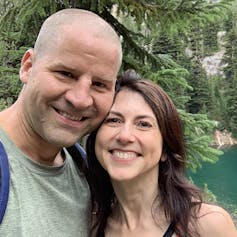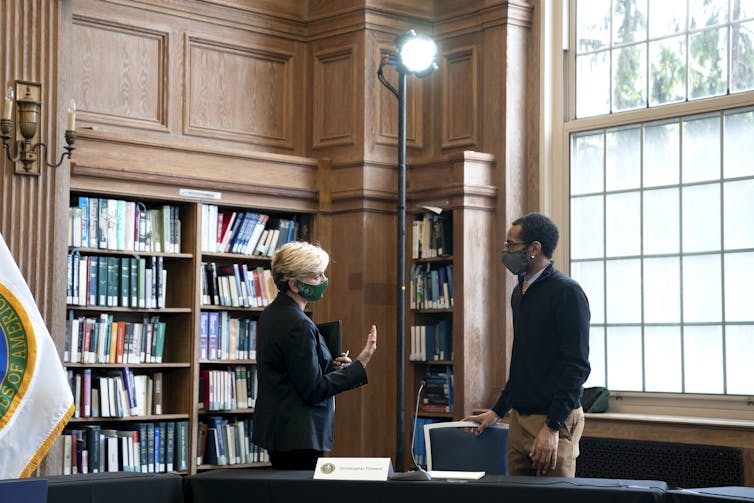How the billions MacKenzie Scott is giving to colleges attended by students of color will help everyone in America
- Written by Ivory A. Toldson, Professor of Counseling Psychology, Howard University
When billionaire philanthropist MacKenzie Scott[1] announced her third round of charitable gifts in June 2021, she said she was giving US$2.7 billion to 286 organizations. This list includes 31 colleges and universities serving people of color and other underserved communities.
That’s on top of the $4.2 billion Scott announced in December 2020[2] to support 384 organizations, including 30 colleges and universities. Her initial plan, announced in July 2020[3], included $1.7 billion for 116 organizations, including several Historically Black Colleges and Universities and other minority-serving institutions[4].
For example, Scott is giving Xavier University of Louisiana, a school that sends more Black graduates to medical school[5] than any other university in the U.S., $20 million[6]; Long Beach City College[7], a California school where more than 85% of students are people of color, $30 million[8]; and Odessa College[9], a Texas school where 74% of students are nonwhite[10], $7 million. All three colleges said Scott’s donations were the largest they had ever received.
As a counseling psychology professor who conducts research regarding the education of Black students[11], I am encouraged to see Scott, a novelist who was formerly married to Amazon founder Jeff Bezos, depart from how billionaires tend to approach their higher education giving. Most make donations to prestigious universities[12] that already have large endowments[13] – money raised from alumni and other donors that they invest in stocks, bonds and other assets. This wealth can cover the cost of scholarships, salaries, construction and any other expenses.
 MacKenzie Scott’s new husband, Dan Jewett, has joined her in a pledge to give away most of their fortune.
Giving Pledge, CC BY-NC-ND[14][15]
MacKenzie Scott’s new husband, Dan Jewett, has joined her in a pledge to give away most of their fortune.
Giving Pledge, CC BY-NC-ND[14][15]
Most wealthy people donate to wealthy schools
Mike Bloomberg, for example, donated $1.8 billion[16] to John Hopkins University, his alma mater, in 2018. Notably, that prestigious school receives[17] more money from federal grants than all of the nation’s 100 HBCUs combined.
Similarly, I question how donations to Harvard University, such as the $30 million[18] from Facebook co-founder Mark Zuckerberg and his wife, Priscilla Chan, can be considered charitable when it already has $41.9 billion in its endowment[19]. Harvard earned a 7.3% return on its endowment assets for its fiscal year that ended in June 2020 – about $3 billion.
Interestingly, I’ve calculated that the total combined annual operating cost of all private HBCUs[20] is also about $3 billion.
Fewer students of color attend ‘national universities’
U.S. News and World Report considers 389 schools to be “national universities[21]” because of their stature[22] and academic offerings. These universities are more likely to receive charitable contributions than others because of their reputation and the large number of affluent people who graduate from them. But these colleges and universities represent fewer than 10% of all institutions of higher education[23].
When I analyzed raw data files from the leading federal database for educational data[24], I found that students of color are less likely to enroll at national universities than their white peers.
I also found that the schools enrolling the most students of color are more likely to be two-year colleges as opposed to a four-year institution; less likely to be prominent research universities; more likely to have significantly high percentages of low-income students; and more likely to have smaller-than-average endowments.
When announcing Scott’s historic donations, many colleges and universities have noted their success with graduating science, technology, engineering and math students.
Florida International University, for example, announced that Scott’s $40 million gift will be used for “student success programs[25].” That school noted its number 6 ranking in terms of awarding engineering degrees to African Americans and the high percentage of its Latino students who earn STEM degrees.
North Carolina A&T[26], the nation’s largest HBCU, announced plans to spend Scott’s $45 million donation[27] in “areas of critical national need, including professions in STEM[28].” The selection of multiple HBCUs, Hispanic-serving and tribal colleges with a track record of graduating underrepresented STEM students seems intentional.
What’s more, recent data suggests that prominent national universities are not graduating enough students[29] overall, apart from racial, ethnic and class considerations, to satisfy the needs of the future workforce.
In 2019, the National Academies of Sciences, Engineering, and Medicine predicted that the nation will need 1 million[30] more STEM professionals than are on pace to earn higher education degrees in the 2020s.
The National Science Board, the governing board for the National Science Foundation, called this impending shortage of STEM professionals the “missing millions[31].” It passed a resolution to address the “urgent need” for more underrepresented groups in the U.S. science and engineering workforce.
A STEM workforce that represents the diversity of the U.S. population can contribute to economic growth[32]. Washington Center for Equitable Growth estimated[33] the nation could earn $5.3 trillion in increased tax revenue from a more skilled workforce if we closed the achievement gap in math and science over the next 60 years. Similarly, a Harvard University report[34] estimated, by calculating national income projections over an 80-year period, the U.S. would add $75 trillion to the GDP if math education was equal.
There are more than 700 minority-serving institutions[35] across the U.S. These colleges and universities enroll nearly 30%[36] of all undergraduates in America. Learners of color, research indicates, find such schools to be more accessible and welcoming[37] than primarily white schools.
What’s more, about half of the students attending minority-serving institutions[38] get Pell Grants, which help cover educational costs for low-income students. And they enroll many students who are the first in their families to go to college[39].
 U.S. Energy Secretary Jennifer Granholm speaks with Howard University student Christopher Flowers about the need for more diversity among STEM students and workers.
Stefani Reynolds-Pool/Getty Images, Author provided[40]
U.S. Energy Secretary Jennifer Granholm speaks with Howard University student Christopher Flowers about the need for more diversity among STEM students and workers.
Stefani Reynolds-Pool/Getty Images, Author provided[40]
A welcome trend
Scott’s approach to giving[41], with its emphasis on racial justice[42], appears to be inspiring others to take a similar approach with their educational philanthropy.
Days after her June 2021 announcement, for example, Google confirmed its plans[43] to commit $50 million to build infrastructure and support scholarships at HBCUs.
I see many reasons beyond charity[44] for philanthropists, the government and corporations to consider donating to colleges and universities that mostly enroll students of color. Among them: It’s a key strategy for helping everyone in America.
[Get the best of The Conversation, every weekend. Sign up for our weekly newsletter[45].]
References
- ^ philanthropist MacKenzie Scott (www.highereddive.com)
- ^ Scott announced in December 2020 (www.insidehighered.com)
- ^ initial plan, announced in July 2020 (mackenzie-scott.medium.com)
- ^ minority-serving institutions (www.doi.gov)
- ^ sends more Black graduates to medical school (www.nytimes.com)
- ^ $20 million (www.bizneworleans.com)
- ^ Long Beach City College (datausa.io)
- ^ $30 million (www.lbcc.edu)
- ^ Odessa College (www.cbs7.com)
- ^ 74% of students are nonwhite (datausa.io)
- ^ who conducts research regarding the education of Black students (scholar.google.com)
- ^ Most make donations to prestigious universities (thebestschools.org)
- ^ large endowments (www.investopedia.com)
- ^ Giving Pledge (givingpledge.org)
- ^ CC BY-NC-ND (creativecommons.org)
- ^ donated $1.8 billion (www.vox.com)
- ^ that prestigious school receives (doi.org)
- ^ $30 million (www.thecrimson.com)
- ^ $41.9 billion in its endowment (www.harvardmagazine.com)
- ^ total combined annual operating cost of all private HBCUs (nces.ed.gov)
- ^ 389 schools to be “national universities (www.usnews.com)
- ^ because of their stature (carnegieclassifications.iu.edu)
- ^ fewer than 10% of all institutions of higher education (www.urbanedjournal.org)
- ^ raw data files from the leading federal database for educational data (nces.ed.gov)
- ^ student success programs (news.fiu.edu)
- ^ North Carolina A&T (affordableschools.net)
- ^ $45 million donation (abc11.com)
- ^ areas of critical national need, including professions in STEM (www.ncat.edu)
- ^ prominent national universities are not graduating enough students (www.nap.edu)
- ^ nation will need 1 million (www.nap.edu)
- ^ missing millions (www.nsf.gov)
- ^ contribute to economic growth (itif.org)
- ^ estimated (live-equitablegrowth.pantheonsite.io)
- ^ Harvard University report (files.eric.ed.gov)
- ^ more than 700 minority-serving institutions (www.nap.edu)
- ^ colleges and universities enroll nearly 30% (www.nap.edu)
- ^ find such schools to be more accessible and welcoming (doi.org)
- ^ half of the students attending minority-serving institutions (doi.org)
- ^ first in their families to go to college (cmsi.gse.rutgers.edu)
- ^ Stefani Reynolds-Pool/Getty Images (www.gettyimages.com)
- ^ approach to giving (givingpledge.org)
- ^ emphasis on racial justice (theconversation.com)
- ^ Google confirmed its plans (www.cnet.com)
- ^ reasons beyond charity (www.postsecondaryvalue.org)
- ^ Sign up for our weekly newsletter (theconversation.com)














